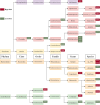Causal associations between gut microbiota and type 2 diabetes mellitus subtypes: a mendelian randomization analysis
- PMID: 40122799
- PMCID: PMC11931760
- DOI: 10.1186/s12902-025-01863-x
Causal associations between gut microbiota and type 2 diabetes mellitus subtypes: a mendelian randomization analysis
Abstract
Purpose: To investigate the causal relationships between gut microbiota and novel adult-onset type 2 diabetes mellitus(T2DM) subtypes.
Methods: We conducted Mendelian randomization (MR) analyses using genome-wide association data from European populations. Initial MR analyses examined associations between gut microbiota and four T2DM subtypes, followed by validation analyses using type 1 diabetes mellitus(T1DM) and T2DM GWAS data. We also performed bidirectional MR analyses and tested for heterogeneity and pleiotropy across all analyses.
Results: Our MR analyses revealed distinctive associations between gut microbiota and T2DM subtypes: six bacterial taxa with severe insulin-deficient diabetes (SIDD), four with severe insulin-resistant diabetes (SIRD), eight with mild obesity-related diabetes (MOD), and eight with mild age-related diabetes (MARD). These associations were distinct from T1DM findings. Six bacterial taxa were validated in T2DM analyses, with four showing directionally consistent effects: Class Clostridia (OR = 0.57, P = 0.045) and Order Clostridiales (OR = 0.57, P = 0.045) were associated with reduced MOD risk, while species Catus (OR = 1.80, P = 0.007) was associated with increased MOD risk, and genus Holdemania (OR = 2.51, P = 0.004) was associated with increased SIRD risk. No significant heterogeneity or pleiotropy was observed across analyses.
Conclusions: Our MR analyses reveal novel causal relationships between gut microbiota and adult-onset T2DM subtypes, though further validation studies are warranted.
Keywords: Genetic variants; Gut microbiota; Mendelian randomization; Type 2 diabetes mellitus.
© 2025. The Author(s).
Conflict of interest statement
Declarations. Ethics approval and consent to participate: Not applicable. Consent for publication: Not applicable. Competing interests: The authors declare no competing interests.
Figures





Similar articles
-
Investigating the causal association between gut microbiota and type 2 diabetes: a meta-analysis and Mendelian randomization.Front Public Health. 2024 Jun 19;12:1342313. doi: 10.3389/fpubh.2024.1342313. eCollection 2024. Front Public Health. 2024. PMID: 38962766 Free PMC article.
-
Differential ischemic stroke risk linked to novel subtypes of type 2 diabetes: insights from a Mendelian randomization analysis.Endocrine. 2024 Jun;84(3):980-988. doi: 10.1007/s12020-024-03842-z. Epub 2024 Apr 30. Endocrine. 2024. PMID: 38691263
-
Genetic associations between gut microbiota and type 2 diabetes mediated by plasma metabolites: a Mendelian randomization study.Front Endocrinol (Lausanne). 2024 Aug 9;15:1430675. doi: 10.3389/fendo.2024.1430675. eCollection 2024. Front Endocrinol (Lausanne). 2024. PMID: 39184139 Free PMC article.
-
Causal relationship between T2DM microvascular complications and gut microbiota: a Mendelian randomization study.Front Endocrinol (Lausanne). 2024 Jun 3;15:1349465. doi: 10.3389/fendo.2024.1349465. eCollection 2024. Front Endocrinol (Lausanne). 2024. PMID: 38887269 Free PMC article.
-
Exploring the potential causal relationship between gut microbiota and heart failure: A two-sample mendelian randomization study combined with the geo database.Curr Probl Cardiol. 2024 Feb;49(2):102235. doi: 10.1016/j.cpcardiol.2023.102235. Epub 2023 Nov 30. Curr Probl Cardiol. 2024. PMID: 38040216 Review.
References
-
- American Diabetes Association. 2. Classification and diagnosis of diabetes: standards of Medical Care in Diabetes—2021. Diabetes Care. 2020;44 Supplement1:S15–33. - PubMed
-
- Franks PW, McCarthy MI. Exposing the exposures responsible for type 2 diabetes and obesity. Science. 2016;354:69–73. - PubMed
-
- Ahlqvist E, Prasad RB, Groop L. 100 YEARS OF INSULIN: towards improved precision and a new classification of diabetes mellitus. J Endocrinol. 2022;252:R59–70. - PubMed
MeSH terms
Grants and funding
LinkOut - more resources
Full Text Sources
Medical

